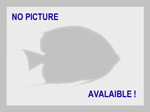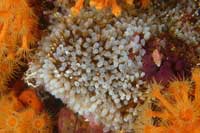|
Aplidium elegans |
Distribution |

|

|
Sea-strawberry |

|
Elegante Seescheide |

|
Elegans koloniezakpijp |

|
Fraise de mer |

|
|

|
Fragola di mare |
|
The temperate Atlantic
The Mediterranean |
|
Surrounding and environment |
|
The species is generally found on the reef
The individuals are gathered in clusters of indefinite shape
The species can be found between 5 and 20 Meters
Rare species.
|
|
General characteristics of the species |
|
Size of the colony : 5 cm
Colonial species : the individuals share their vascular system and or the same exhaling siphon
|
|
Relationship with humans |
|
The species can be eaten but is of no particular culinary interest
|
|
The species can be confused with other species of similar appearance! |
|
Ascidia mentula |
Distribution |

|

|
Pink sea-squirt |

|
Stumpen-Ascidie |

|
Rose zakpijp |

|
Ascidie rose |

|
Ascidia rosada |

|
|
|
The temperate Atlantic
The Mediterranean |
|
Surrounding and environment |
|
The species is generally found on the reef
The species can be found between 1 and 200 Meters
Uncommon Species
|
|
General behaviour of the species |
|
The animal retracts or curls up if it is disturbed
|
|
General characteristics of the species |
|
Size of the individual : 18 cm
The animal can show variable colouring
|
|
Relationship with humans |
|
The species can be eaten but is of no particular culinary interest
|
|
Ascidiella aspersa |
Distribution |

|

|
Dirty sea-squirt |

|
Spritz-Ascidie |

|
Gore zakpijp |

|
Ascidie sale |

|
Ascidia sucia |

|
|
|
The temperate Atlantic
The Mediterranean |
|
Surrounding and environment |
|
The species is generally found on the reef
The individuals are gathered to form a bouquet
The species can be found between 1 and 80 Meters
Uncommon Species
|
|
General behaviour of the species |
|
The animal retracts or curls up if it is disturbed
|
|
General characteristics of the species |
|
Size of the individual : 13 cm
|
|
Relationship with humans |
|
The species can be eaten but is of no particular culinary interest
|
|
The species can be confused with other species of similar appearance! |
|
Botryllus schlosseri |
Distribution |

|

|
Star tunicate |

|
Stern-Seescheide |

|
Gesterde geleikorst |

|
Botrylle étoilé |

|
Botryllus |

|
Botrillo |
|
The temperate Atlantic
The Mediterranean |
|
Surrounding and environment |
|
The species is generally found on the reef
The colony of individuals forms a crust on the substrate
The species can be found between 0 and 100 Meters
Uncommon Species
|
|
General characteristics of the species |
|
Size of the individual : 0.5 cm
Size of the colony : 20 cm
The animal can show variable colouring
Colonial species : the individuals share their vascular system and or the same exhaling siphon
|
|
Relationship with humans |
|
The species can be eaten but is of no particular culinary interest
|
|
The species can be confused with other species of similar appearance! |
|
Ciona intestinalis |
Distribution |

|

|
Yellow sea-squirt |

|
Gelbe Seescheide |

|
Doorzichtige zakpijp |

|
Cione |

|
Ascidia amarilla |

|
Ascidia lunga |
|
The temperate Atlantic
The Mediterranean |
|
Surrounding and environment |
|
The species is generally found on the reef
The tunicate is found isolated
The species can be found between 1 and 1000 Meters
Rare species.
|
|
General behaviour of the species |
|
The animal retracts or curls up if it is disturbed
|
|
General characteristics of the species |
|
Size of the individual : 20 cm
|
|
Relationship with humans |
|
The species can be eaten but is of no particular culinary interest
|
|
The species can be confused with other species of similar appearance! |
|
Clavelina lepadiformis |
Distribution |

|

|
Transparent seasquirt |

|
Durchscheinende Seescheide |

|
Doorzichtige zakpijp |

|
Grande claveline |

|
Clavelina |

|
Clavelina |
|
The temperate Atlantic
The Mediterranean |
|
Surrounding and environment |
|
The species is generally found on the reef
The individuals are gathered to form a bouquet
The species can be found between 1 and 50 Meters
Uncommon Species
|
|
General characteristics of the species |
|
Size of the individual : 3 cm
Size of the colony : 20 cm
Colonial species : the individuals share their vascular system and or the same exhaling siphon
|
|
Relationship with humans |
The species can be eaten but is of no particular culinary interest
The species is exploited in the following sector(s) :
- Aquarium enthusiasts.
|
|
The species can be confused with other species of similar appearance! |
|
Clavelina dellavallei |
Distribution |

|

|
Bluestriped light bulb tunicate |

|
Durchscheinende Seescheide |

|
Glaszakpijp |

|
Claveline bleutée |

|
Clavelina |

|
Ascidia trasparente |
|
The temperate Atlantic
The Mediterranean |
|
Surrounding and environment |
|
The species is generally found on the reef
The individuals are gathered in clusters of indefinite shape
The species can be found between 1 and 90 Meters
Uncommon Species
|
|
General characteristics of the species |
|
Size of the individual : 6 cm
Size of the colony : 30 cm
|
|
Relationship with humans |
|
The species can be eaten but is of no particular culinary interest
|
|
The species can be confused with other species of similar appearance! |
|
Clavelina nana |
Distribution |

|

|
Midget seasquirt |

|
Kleine Keulenseescheiden |

|
Dwergzakpijp |

|
Claveline naine |

|
Clavelina enana |

|
Clavelina nana |
|
The temperate Atlantic
The Mediterranean |
|
Surrounding and environment |
|
The species is generally found on the reef
The individuals are gathered to form a bouquet
The species can be found between 1 and 40 Meters
Rare species.
|
|
General characteristics of the species |
|
Size of the individual : 1 cm
The animal can show variable colouring
|
|
Relationship with humans |
The species can be eaten but is of no particular culinary interest
The species is exploited in the following sector(s) :
- Aquarium enthusiasts.
|
|
The species can be confused with other species of similar appearance! |
|
Diazona violacea |
Distribution |

|

|
football ascidian |

|
Koloniebildende Seescheide |

|
Diazona |

|
Diazone |

|
Diazona |

|
Diazona |
|
The temperate Atlantic
The Mediterranean |
|
Surrounding and environment |
|
The species is generally found on the reef
The individuals are gathered to form a bouquet
The species can be found between 15 and 200 Meters
Uncommon Species
|
|
General characteristics of the species |
|
Size of the individual : 5 cm
Size of the colony : 40 cm
The animal can show variable colouring
|
|
Relationship with humans |
|
The species can be eaten but is of no particular culinary interest
|
|
The species can be confused with other species of similar appearance! |
|
Didemnum sp |
Distribution |

|

|
Didemnum |

|
Riffseescheide |

|
Didemnum |

|
Synascidie encroûtante |

|
Didemnum |

|
Didemnum |
|
The temperate Atlantic
The Mediterranean |
|
Surrounding and environment |
|
The species is generally found on the reef
The colony of individuals forms a crust on the substrate
The species can be found between 1 and 40 Meters
Uncommon Species
|
|
General characteristics of the species |
|
Size of the colony : 15 cm
The animal can show variable colouring
Colonial species : the individuals share their vascular system and or the same exhaling siphon
|
|
Relationship with humans |
The species can be eaten but is of no particular culinary interest
The species is exploited in the following sector(s) :
- Chemistry/pharmacy.
|
|
The species can be confused with other species of similar appearance! |
|
Didemnum molle |
Distribution |

|

|
Tall urn ascidian |

|
Grüne Riffseescheide |

|
Grote kolonievormende urnzakpijp |

|
Grande synascidie-urne |

|
Ascidia urna verde |

|
|
|
The tropical Pacific
The Red Sea
The Indian Ocean |
|
Surrounding and environment |
|
The species is generally found on the reef
The individuals are gathered in clusters of indefinite shape
The species can be found between 0 and 60 Meters
Uncommon Species
|
|
General characteristics of the species |
|
Size of the colony : 10 cm
The animal can show variable colouring
Colonial species : the individuals share their vascular system and or the same exhaling siphon
|
|
Relationship with humans |
|
The species can be eaten but is of no particular culinary interest
|
|
Eusynstyela misakiensis |
Distribution |

|

|
Apricot synascidia |

|
Kolonie - Seescheide |

|
|

|
Ascidie encroûtante |

|
Ascidia albaricoque |

|
Ascidia incrostante |
|
The Red Sea
The Indian Ocean |
|
Surrounding and environment |
|
The species is generally found on the reef
The colony of individuals forms a crust on the substrate
The species can be found between 5 and 30 Meters
Uncommon Species
|
|
General characteristics of the species |
|
Size of the individual : 1 cm
Size of the colony : 50 cm
The animal can show variable colouring
|
|
Relationship with humans |
|
The species can be eaten but is of no particular culinary interest
|
|
The species can be confused with other species of similar appearance! |
|
Halocynthia papillosa |
Distribution |

|

|
Red seasquirt |

|
Rote Seescheide |

|
Rode zakpijp |

|
Ascidie rouge |

|
Ascidia rojo |

|
Ascidia rossa |
|
The temperate Atlantic
The Mediterranean |
|
Surrounding and environment |
The species is generally found on the reef
The tunicate is found isolated
The species can be found between 0 and 100 Meters
Very common species.
|
|
General behaviour of the species |
|
The animal retracts or curls up if it is disturbed
|
|
General characteristics of the species |
|
Size of the individual : 20 cm
|
|
Relationship with humans |
The species can be eaten but is of no particular culinary interest
The species is exploited in the following sector(s) :
- Aquarium enthusiasts.
|
|
Halocynthia spinosa |
Distribution |

|

|
Spiny ascidian |

|
Stachelige Seescheide |

|
|

|
Ascidie épineuse |

|
Ascidia espinosa |

|
Halocinzia spinosa |
|
The Red Sea
The Indian Ocean |
|
Surrounding and environment |
|
The species is generally found on the reef
The tunicate is found isolated
The species can be found between 0 and 100 Meters
Uncommon Species
|
|
General behaviour of the species |
|
The animal retracts or curls up if it is disturbed
|
|
General characteristics of the species |
|
Size of the individual : 3 cm
|
|
Relationship with humans |
|
The species can be eaten but is of no particular culinary interest
|
|
Herdmania momus |
Distribution |

|

|
Herdman's ascidian |

|
Herdmania - Seescheide |

|
|

|
Ascidie brune |

|
Ascidia solitaria roja |

|
Ascidia bruna |
|
The tropical Pacific
The Red Sea
The Indian Ocean
The Mediterranean |
|
Surrounding and environment |
|
The species is generally found on the reef
The tunicate is found isolated
The species can be found between 5 and 100 Meters
Uncommon Species
|
|
General behaviour of the species |
|
The animal retracts or curls up if it is disturbed
|
|
General characteristics of the species |
|
Size of the individual : 10 cm
|
|
Relationship with humans |
|
The species can be eaten but is of no particular culinary interest
|
|
Microcosmus sabatieri |
Distribution |

|

|
Violets |

|
Eßbare Seescheide |

|
Begroeide zakpijp |

|
Violet |

|
Patatas de mar |

|
Limone di mare |
|
The Mediterranean |
|
Surrounding and environment |
|
The species is generally found on the reef
The individuals are gathered in clusters of indefinite shape
The species can be found between 5 and 200 Meters
Common species.
Endemic species.
|
|
General behaviour of the species |
|
The animal retracts or curls up if it is disturbed
|
|
General characteristics of the species |
|
Size of the individual : 25 cm
|
|
Relationship with humans |
The species is in great demand and highly appreciated
The species is exploited in the following sector(s) :
- Fishing or commercial aquiculture for food.
|
|
The species can be confused with other species of similar appearance! |
|
Molgula manhattensis |
Distribution |

|

|
Molgula |

|
Meertraube |

|
Zeedruif zijker |

|
Molgule |

|
Uva marina |

|
|
|
The temperate Atlantic |
|
Surrounding and environment |
|
The species is generally found on the reef
The tunicate is found isolated
The species can be found between 1 and 90 Meters
Common species.
|
|
General behaviour of the species |
|
The animal retracts or curls up if it is disturbed
|
|
General characteristics of the species |
|
Size of the individual : 4 cm
The animal can show variable colouring
|
|
Relationship with humans |
|
The species can be eaten but is of no particular culinary interest
|
|
The species can be confused with other species of similar appearance! |
|
Phallusia julinea |
Distribution |

|

|
Yellow sea-squirt |

|
Gelbpunkt Seescheide |

|
|

|
Ascidie jaune |

|
Ascidia amarilla |

|
Ascidia gialla |
|
The tropical Pacific
The Red Sea
The Indian Ocean |
|
Surrounding and environment |
|
The species is generally found on the reef
The tunicate is found isolated
The species can be found between 5 and 100 Meters
Uncommon Species
|
|
General behaviour of the species |
|
The animal retracts or curls up if it is disturbed
|
|
General characteristics of the species |
|
Size of the individual : 20 cm
|
|
Relationship with humans |
The species can be eaten but is of no particular culinary interest
The species is exploited in the following sector(s) :
- Chemistry/pharmacy.
|
|
Polyandrocarpa tumida |
Distribution |

|

|
Mottled social tunicate |

|
Flecken-Kolonieseescheide |

|
Gevlekte kolonievormende zakpijp |

|
Ascidie coloniale tachetée |

|
Ascidia colonial moteada |

|
|
|
The tropical Atlantic |
|
Surrounding and environment |
|
The species is generally found on the reef
The individuals are gathered in clusters of indefinite shape
The species can be found between 8 and 25 Meters
Uncommon Species
|
|
General characteristics of the species |
|
Size of the individual : 1.5 cm
Colonial species : the individuals share their vascular system and or the same exhaling siphon
|
|
Relationship with humans |
|
The species can be eaten but is of no particular culinary interest
|
|
The species can be confused with other species of similar appearance! |
|
Polycarpa spongiabilis |
Distribution |

|

|
Giant tunicate |

|
Riesenseescheide |

|
Reuzenzakpijp |

|
Ascidie géante |

|
Ascidia gigante |

|
|
|
The tropical Atlantic |
|
Surrounding and environment |
|
The species is generally found on the reef
The tunicate is found isolated
The species can be found between 8 and 35 Meters
Uncommon Species
|
|
General behaviour of the species |
|
The animal retracts or curls up if it is disturbed
|
|
General characteristics of the species |
|
Size of the individual : 11 cm
|
|
Relationship with humans |
|
The species can be eaten but is of no particular culinary interest
|
|
Pyura microcosmus |
Distribution |

|

|
Small microcosm |

|
Kleine Mikrokosmus-Seescheide |

|
Kleine mikrokosmos |

|
Petit microcosme |

|
Probecho pequeño |

|
|
|
The temperate Atlantic
The Mediterranean |
|
Surrounding and environment |
|
The species is generally found on the reef
The tunicate is found isolated
The species can be found between 1 and 40 Meters
Uncommon Species
|
|
General behaviour of the species |
|
The animal retracts or curls up if it is disturbed
|
|
General characteristics of the species |
|
Size of the individual : 3 cm
|
|
Relationship with humans |
|
The species can be eaten but is of no particular culinary interest
|
|
The species can be confused with other species of similar appearance! |

